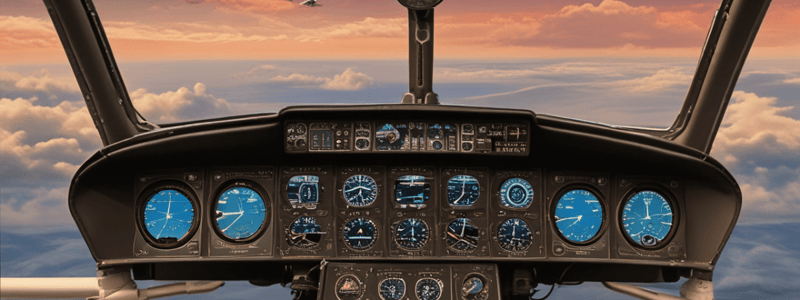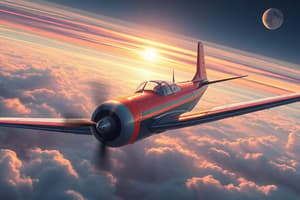Podcast
Questions and Answers
What is the primary purpose of regular practice interpreting the PFD's synthetic representation of the outside world?
What is the primary purpose of regular practice interpreting the PFD's synthetic representation of the outside world?
- To develop situational awareness (correct)
- To improve communication skills
- To reduce workload during flight
- To enhance navigational skills
What feature of the PFD enhances situational awareness?
What feature of the PFD enhances situational awareness?
- Artificial horizon line
- Weather radar
- Navigation aids like the Horizontal Situation Indicator (HSI) (correct)
- Radio communication systems
What is the primary function of Multi-Function Displays (MFDs)?
What is the primary function of Multi-Function Displays (MFDs)?
- To offer a versatile platform for accessing a wide range of information (correct)
- To monitor engine performance and fuel consumption
- To provide a synthetic representation of the outside world
- To display primary flight instruments
What skill is essential for efficient use of MFDs?
What skill is essential for efficient use of MFDs?
What is a critical aspect of cockpit management involving PFDs and MFDs?
What is a critical aspect of cockpit management involving PFDs and MFDs?
What is the benefit of understanding the redundancy and interaction between PFD and MFD?
What is the benefit of understanding the redundancy and interaction between PFD and MFD?
Why is it important to stay current with the latest software updates?
Why is it important to stay current with the latest software updates?
What is a key aspect of integrating the functions of PFDs and MFDs into cockpit management?
What is a key aspect of integrating the functions of PFDs and MFDs into cockpit management?
What is the primary benefit of using MFDs?
What is the primary benefit of using MFDs?
What is a critical aspect of effective cockpit management?
What is a critical aspect of effective cockpit management?
Real-time monitoring for optimal engine health is only possible with primary flight displays.
Real-time monitoring for optimal engine health is only possible with primary flight displays.
MFDs solely serve as a hub for effective cockpit management.
MFDs solely serve as a hub for effective cockpit management.
Mastering the use of MFDs is only essential for commercial pilots.
Mastering the use of MFDs is only essential for commercial pilots.
The integration of communication systems is not a crucial aspect of MFDs.
The integration of communication systems is not a crucial aspect of MFDs.
Effective cockpit management is only necessary for safe flight operations.
Effective cockpit management is only necessary for safe flight operations.
Primary Flight Displays (PFDs) do not provide a consolidated view of critical flight data.
Primary Flight Displays (PFDs) do not provide a consolidated view of critical flight data.
Familiarizing oneself with the layout and functionality of MFDs is not essential for effective cockpit management.
Familiarizing oneself with the layout and functionality of MFDs is not essential for effective cockpit management.
Terrain awareness is not a critical aspect of situational alertness.
Terrain awareness is not a critical aspect of situational alertness.
The use of primary flight displays (PFDs) is optional in modern cockpits.
The use of primary flight displays (PFDs) is optional in modern cockpits.
Cockpit management is only relevant for pilots of complex aircraft.
Cockpit management is only relevant for pilots of complex aircraft.
What is the primary advantage of the PFD's synthetic representation of the outside world?
What is the primary advantage of the PFD's synthetic representation of the outside world?
How does the integration of navigation aids like the Horizontal Situation Indicator (HSI) enhance situational awareness?
How does the integration of navigation aids like the Horizontal Situation Indicator (HSI) enhance situational awareness?
What is the key benefit of being able to quickly bring up necessary information on the MFD without becoming distracted from the primary task of flying the aircraft?
What is the key benefit of being able to quickly bring up necessary information on the MFD without becoming distracted from the primary task of flying the aircraft?
What is the significance of establishing a systematic approach to monitoring and controlling the aircraft in cockpit management?
What is the significance of establishing a systematic approach to monitoring and controlling the aircraft in cockpit management?
How does understanding the redundancy and interaction between PFD and MFD contribute to effective cockpit management?
How does understanding the redundancy and interaction between PFD and MFD contribute to effective cockpit management?
What is the primary benefit of staying current with the latest software updates in modern cockpit management?
What is the primary benefit of staying current with the latest software updates in modern cockpit management?
How does the integration of PFDs and MFDs contribute to a pilot's overall situational awareness?
How does the integration of PFDs and MFDs contribute to a pilot's overall situational awareness?
What is the key challenge in using MFDs efficiently in modern cockpit management?
What is the key challenge in using MFDs efficiently in modern cockpit management?
What is the primary benefit of having a consolidated view of critical flight data on the PFD?
What is the primary benefit of having a consolidated view of critical flight data on the PFD?
What is the significance of regularly checking critical information on the PFD and MFD in cockpit management?
What is the significance of regularly checking critical information on the PFD and MFD in cockpit management?
Study Notes
Primary Flight Displays (PFDs)
- PFDs are an essential component of modern avionics, consolidating critical flight data into one interface.
- A typical PFD layout presents a wealth of flight information at a glance, including attitude, airspeed, altitude, and heading.
- The PFD serves as the primary reference for attitude and airspeed, fundamental forces in any phase of flight.
- Managing PFD readings is crucial for maintaining the intended flight path and altitude, especially in complex airspaces or when responding to air traffic control instructions.
Functions of PFDs
- PFDs provide essential flight information, including vertical speed and navigation data, which helps in flight planning and navigation.
- The PFD is an interactive tool, requiring pilots to interpret and respond to warnings and cautions.
- PFDs can display a wealth of information, including altitude, airspeed, and heading, which is vital for maintaining situational awareness.
Multi-Function Displays (MFDs)
- MFDs are an integral part of modern avionics, providing a customizable platform for accessing a wide range of information.
- MFDs can display a moving map, showing the aircraft's position relative to terrain, airways, and waypoints, which is vital for flight planning and en route navigation.
- MFDs can also provide access to weather information, allowing pilots to make informed decisions to avoid adverse conditions.
- Engine monitoring and performance data can be displayed on MFDs, facilitating preemptive maintenance and optimal engine management.
Scenarios for MFD Use
- Scenario 1: Navigational Aids and MFD Usage - MFDs can display a moving map, showing the aircraft's position relative to terrain, airways, and waypoints.
- Scenario 2: Weather Information - MFDs can provide access to weather radar data and real-time updates from services like XM Weather.
- Scenario 3: Engine Monitoring and Performance Data - MFDs can display engine performance data, including fuel burn, oil pressure, and engine temperatures.
- Scenario 4: Terrain Awareness and MFD Mapping Features - MFDs can provide terrain mapping and obstacle databases, which enhance situational awareness.
- Scenario 5: Integration of Communication Systems - MFDs can integrate radio frequencies, transponder codes, and inter-aircraft communication channels, streamlining cockpit management.
Effective Cockpit Management
- Effective cockpit management involves integrating PFD and MFD functions into a systematic approach to monitoring and controlling the aircraft.
- Developing a scan pattern that includes both displays is crucial for ensuring critical information is regularly checked.
- Understanding the redundancy and interaction between PFD and MFD is essential for cross-checking information and being prepared to revert to backup instruments if necessary.
- Staying current with software updates and understanding how changes may affect the presentation of information or functionality is vital for effective cockpit management.
Primary Flight Displays (PFDs)
- A typical PFD layout presents a wealth of flight information at a glance
- Core functions of a PFD include:
- Attitude and airspeed
- Heading and altitude data
- Vertical speed and navigation information
- Understanding how to manage these readings is crucial for maintaining the intended flight path and altitude
- PFDs serve as the primary reference for attitude and airspeed
Interactive Features of PFDs
- PFDs are interactive tools that require understanding how to interpret and respond to warnings and cautions
- Autopilot controls are a facet of the PFD, enabling pilots to manage autopilot settings and reduce pilot workload
- PFDs allow pilots to switch between various views as they transition through different flight phases
- Customizing PFD settings enables pilots to tailor the display to personal preferences and flight conditions
Cross-Checking PFD Readings
- Best practices involve cross-checking PFD readings with standby instruments for redundancy
- This habit ensures that pilots can rely on classic instrumentation in case of modern avionics failure
Effective PFD Integration into Cockpit Management
- By understanding the layout and functions, responding to warnings, managing autopilot controls, and maintaining situational awareness through PFDs, pilots can set themselves up for successful flights
- Harnessing PFD technology without surrendering the sharpness of pilot instincts is crucial
Multi-Function Displays (MFDs)
- MFDs provide access and interpretation of a vast amount of information from navigational aids to engine performance data
- Customizable screens enable pilots to display essential information
MFD Use Cases
- Scenario 1: MFDs can display a moving map, showing the aircraft's position relative to terrain, airways, and waypoints, vital for flight planning and en route navigation
- Scenario 2: MFDs can provide direct access to weather information, enabling pilots to make informed decisions to avoid adverse conditions
- Scenario 3: MFDs can display engine monitoring and performance data, facilitating preemptive maintenance and optimal engine management
- Scenario 4: MFDs can provide terrain awareness and obstacle databases, increasing safety, especially in challenging environments
- Scenario 5: MFDs can integrate communication systems, centralizing control within the MFD interface
Integrated Cockpit Management
- Effective MFD utilization declutters the cockpit and streamlines the pilot's workflow
- Synthesizing information from various systems onto a single or dual MFDs enhances situational awareness and cockpit management
Effective Cockpit Management
- Mastery in utilizing MFDs fosters confidence during flights and elevates airmanship skills
- Effective cockpit management is paramount for the safety and efficiency of flight operations
Primary Flight Displays (PFDs)
- PFDs are essential components of modern avionics, consolidating critical flight data into a sophisticated interface.
- A typical PFD layout presents a wealth of flight information at a glance, including attitude, airspeed, heading, and altitude data.
- PFDs serve as the primary reference for attitude and airspeed, fundamental forces at play in any phase of flight.
- Understanding how to manage PFD readings is crucial for maintaining the intended flight path and altitude, especially when navigating through complex airspaces or responding to air traffic control instructions.
PFD Functions and Management
- PFDs provide vertical speed and navigation information, guiding pilots as they manage their overall navigation plan.
- PFDs are interactive tools, requiring pilots to interpret and respond to warnings and cautions.
- Autopilot controls are an integral part of the PFD, enabling pilots to manage autopilot settings and reduce pilot workload during critical stages of flight.
- PFDs can be customized to suit individual preferences and flight conditions, allowing pilots to tailor the data displayed to their specific needs.
Situational Awareness and Redundancy
- Situational awareness remains paramount in cockpit management, even with the use of advanced technology like PFDs.
- Best practices for cross-checking PFD readings with standby instruments ensure safety in case of modern avionics failure.
- Pilots must develop a systematic approach to monitoring and controlling the aircraft, integrating PFD functions into their cockpit management strategy.
Multi-Function Displays (MFDs)
- MFDs provide pilots with a vast amount of information, including navigational aids, engine performance data, and weather updates.
- MFDs can display a moving map, showing the aircraft's position relative to terrain, airways, and waypoints.
- MFDs allow pilots to access weather information, including weather radar data and real-time updates from services like XM Weather.
- MFDs can display engine performance data, enabling pilots to monitor parameters such as fuel burn, oil pressure, and engine temperatures.
MFD Scenarios and Use Cases
- Scenario 1: Navigational Aids and MFD Usage - MFDs display a moving map, assisting pilots in maintaining situational awareness.
- Scenario 2: Weather Information and MFDs - MFDs provide pilots with direct access to weather updates, enabling informed decision-making.
- Scenario 3: Engine Monitoring and Performance Data on MFDs - MFDs allow pilots to monitor engine parameters, facilitating preemptive maintenance and optimal engine management.
- Scenario 4: Terrain Awareness and MFD Mapping Features - MFDs provide terrain mapping and obstacle databases, increasing safety in challenging environments.
- Scenario 5: Integration of Communication Systems in MFD - MFDs centralize control within the MFD interface, streamlining cockpit management.
Integrating PFD and MFD Functions
- Effective cockpit management involves integrating PFD and MFD functions, developing a systematic approach to monitoring and controlling the aircraft.
- Pilots must learn to navigate through the various PFD and MFD pages and menus, understanding how to quickly bring up necessary information without becoming distracted from the primary task of flying the aircraft.
- Integrating PFD and MFD functions enhances situational awareness, improves cockpit management, and ensures safety in modern aircraft.
Studying That Suits You
Use AI to generate personalized quizzes and flashcards to suit your learning preferences.
Related Documents
Description
Learn about Primary Flight Displays (PFDs), essential components of modern avionics, and understand their layout, functionality, and importance in maintaining flight safety.




